The Most Economical Mode of Power Supply for Remote and Less Developed Areas in China: Power Grid Extension or Micro-Grid?
Abstract
:1. Introduction
2. Power Supply Modes in Remote and Less Developed Areas
2.1. Power Grid Extension Mode
2.2. Micro-Grid Mode
3. Method
3.1. The Basic Theory of LCOE
3.2. LCOE Model for Power Grid Extension Mode
3.2.1. Power Generation LCOE
3.2.2. Power Transmission LCOE
3.2.3. Power Distribution LCOE
3.2.4. LCOE of Power Grid Extension Mode
3.3. LCOE Model for Micro-Grid Mode
4. Empirical Analysis
4.1. LCOE Calculation for Power Grid Extension Mode
4.1.1. LCOE Accounting of Power Generation
4.1.2. LCOE Accounting of Power Transmission
4.1.3. LCOE Accounting of Power Distribution
4.2. LCOE Calculation for Micro-Grid Mode
4.3. The Most Economical Mode Selection
5. Conclusions
Acknowledgments
Author Contributions
Conflicts of Interest
References
- Guo, S.; Zhao, H. Optimal site selection of electric vehicle charging station by using fuzzy TOPSIS based on sustainability perspective. Appl. Energy 2015, 158, 390–402. [Google Scholar] [CrossRef]
- Zhao, H.; Guo, S.; Li, H. Economic impact assessment of wind power integration: A quasi-public goods property perspective. Energies 2015, 8, 8749–8774. [Google Scholar] [CrossRef]
- Omer, A.M. Energy, environment and sustainable development. Renew. Sustain. Energy Rev. 2008, 12, 2265–2300. [Google Scholar] [CrossRef]
- Li, L.; Tan, Z.; Wang, J.; Xu, J.; Cai, C.; Hou, Y. Energy conservation and emission reduction policies for the electric power industry in China. Energy Policy 2011, 39, 3669–3679. [Google Scholar] [CrossRef]
- Zhao, H.; Guo, S.; Zhang, Q.; Li, C. Social Welfare Evaluation of Electric Universal Service in China: From the Perspective of Sustainability. Sustainability 2014, 6, 4949–4965. [Google Scholar] [CrossRef]
- Guo, S.; Zhao, H.; Li, C.; Zhao, H.; Li, B. Significant Factors Influencing Rural Residents’ Well-Being with Regard to Electricity Consumption: An Empirical Analysis in China. Sustainability 2016, 8, 1132. [Google Scholar] [CrossRef]
- Zhao, H.-R.; Li, C.-J.; Chi, N.-N.; Cui, B. Comprehensive evaluation on social value of electric power universal service. Power Syst. Technol. 2009, 33, 99–105. [Google Scholar]
- State-Council-of-China. China’s Energy Policy (2012); Information Office of the State Council: Beijing, China, 2012.
- National-Energy-Administration. Three-Year Action Plan for Comprehensively Solving Electric Usage Problems for Rural Residents (2013–2015); Office of Comprehensive Division of National Energy Administration: Beijing, China, 2013.
- National-Energy-Administration. Implementation Opinions of Speeding up Energy Development in Poor Areas to Promote Poverty Alleviation (2016); Office of Comprehensive Division of National Energy Administration: Beijing, China, 2016.
- National-Energy-Administration Promote the Construction of New Energy Micro-Grid Demonstration Project. Available online: http://zfxxgk.nea.gov.cn/auto87/201507/t20150722_1949.htm (accessed on 10 May 2016).
- Mahapatra, S.; Dasappa, S. Rural electrification: Optimising the choice between decentralised renewable energy sources and grid extension. Energy Sustain. Dev. 2012, 16, 146–154. [Google Scholar] [CrossRef]
- Luo, G.-L.; Wang, Y.-H. The Analysis on Current Situation, Difficulties and Strategies on Power Universal Service in China Rural Areas. J. N. China Electr. Power Univ. (Soc. Sci.) 2007, 3, 1–5. [Google Scholar]
- Zhang, F.-W.; Yan, L.-M.; Zhao, Y.-M. Compensation mechanism study of universal power services. Power Demand Side Manag. 2007, 2, 21–23. [Google Scholar]
- Ouyang, X.; Lin, B. Levelized cost of electricity (LCOE) of renewable energies and required subsidies in China. Energy Policy 2014, 70, 64–73. [Google Scholar] [CrossRef]
- Said, M.; EL-Shimy, M.; Abdelraheem, M. Photovoltaics energy: Improved modeling and analysis of the levelized cost of energy (LCOE) and grid parity–Egypt case study. Sustain. Energy Technol. Assess. 2015, 9, 37–48. [Google Scholar] [CrossRef]
- Ouedraogo, B.I.; Kouame, S.; Azoumah, Y.; Yamegueu, D. Incentives for rural off grid electrification in Burkina Faso using LCOE. Renew. Energy 2015, 78, 573–582. [Google Scholar] [CrossRef]
- Ueckerdt, F.; Hirth, L.; Luderer, G.; Edenhofer, O. System LCOE: What are the costs of variable renewables? Energy 2013, 63, 61–75. [Google Scholar] [CrossRef]
- Hernández-Moro, J.; Martínez-Duart, J. Analytical model for solar PV and CSP electricity costs: Present LCOE values and their future evolution. Renew. Sustain. Energy Rev. 2013, 20, 119–132. [Google Scholar] [CrossRef]
- Castro-Santos, L.; Garcia, G.P.; Estanqueiro, A.; Justino, P.A. The Levelized Cost of Energy (LCOE) of wave energy using GIS based analysis: The case study of Portugal. Int. J. Electr. Power Energy Syst. 2015, 65, 21–25. [Google Scholar] [CrossRef]
- Townsend, A.K.; Webber, M.E. An integrated analytical framework for quantifying the LCOE of waste-to-energy facilities for a range of greenhouse gas emissions policy and technical factors. Waste Manag. 2012, 32, 1366–1377. [Google Scholar] [CrossRef] [PubMed]
- Zupone, G.L.; Amelio, M.; Barbarelli, S.; Florio, G.; Scornaienchi, N.M.; Cutrupi, A. Lcoe evaluation for a tidal kinetic self balancing turbine: Case study and comparison. Appl. Energy 2017, 185, 1292–1302. [Google Scholar] [CrossRef]
- Liu, Z.; Zhang, W.; Zhao, C.; Yuan, J. The economics of wind power in China and policy implications. Energies 2015, 8, 1529–1546. [Google Scholar] [CrossRef]
- Rojas-Zerpa, J.C.; Yusta, J.M. Application of multicriteria decision methods for electric supply planning in rural and remote areas. Renew. Sustain. Energy Rev. 2015, 52, 557–571. [Google Scholar] [CrossRef]
- Huang, D.; Shu, Y.; Ruan, J.; Hu, Y. Ultra high voltage transmission in China: Developments, current status and future prospects. IEEE Proc. 2009, 97, 555–583. [Google Scholar] [CrossRef]
- Wang, Y.; Wang, J.; Dong, X.; Du, P.; Ni, M.; Wang, C.; Yao, L.; Zhang, B.; Chen, C. Guest Editorial Smart Grid Technologies and Development in China. IEEE Trans. Smart Grid 2016, 7, 379–380. [Google Scholar] [CrossRef]
- Zhenya, L. Innovation of UHVAC transmission technology in China. Power Syst. Technol. 2013, 37, 1–8. [Google Scholar]
- Xu, Z.; Dong, H.; Huang, H. Debates on ultra-high-voltage synchronous power grid: The future super grid in China? IET Gener. Transm. Distrib. 2015, 9, 740–747. [Google Scholar] [CrossRef]
- Zhu, F.; Zhao, H.-G.; Liu, Z.-H.; Kou, H.-Z. The influence of large power grid interconnected on power system dynamic stability. CSEE Proc. 2007, 1, 1–7. [Google Scholar]
- Yu, W.; Xue, Y.; Luo, J.; Ni, M.; Tong, H.; Huang, T. An UHV grid security and stability defense system: Considering the risk of power system communication. IEEE Trans. Smart Grid 2016, 7, 491–500. [Google Scholar] [CrossRef]
- Singh, A.K.; Singh, R.; Pal, B.C. Stability analysis of networked control in smart grids. IEEE Trans. Smart Grid 2015, 6, 381–390. [Google Scholar] [CrossRef]
- Bruni, G.; Cordiner, S.; Mulone, V. Domestic distributed power generation: Effect of sizing and energy management strategy on the environmental efficiency of a photovoltaic-battery-fuel cell system. Energy 2014, 77, 133–143. [Google Scholar] [CrossRef]
- Blaabjerg, F.; Teodorescu, R.; Liserre, M.; Timbus, A.V. Overview of control and grid synchronization for distributed power generation systems. IEEE Trans. Ind. Electron. 2006, 53, 1398–1409. [Google Scholar] [CrossRef]
- Pepermans, G.; Driesen, J.; Haeseldonckx, D.; Belmans, R.; D’haeseleer, W. Distributed generation: Definition, benefits and issues. Energy Policy 2005, 33, 787–798. [Google Scholar] [CrossRef]
- Lopes, J.P.; Hatziargyriou, N.; Mutale, J.; Djapic, P.; Jenkins, N. Integrating distributed generation into electric power systems: A review of drivers, challenges and opportunities. Electr. Power Syst. Res. 2007, 77, 1189–1203. [Google Scholar] [CrossRef]
- Driesen, J.; Belmans, R. Distributed generation: Challenges and possible solutions. In Proceedings of the IEEE Power Engineering Society General Meeting, Montreal, QC, Canada, 18–22 June 2006; p. 8. [Google Scholar]
- Keane, A.; Ochoa, L.F.; Borges, C.L.; Ault, G.W.; Alarcon-Rodriguez, A.D.; Currie, R.A.; Pilo, F.; Dent, C.; Harrison, G.P. State-of-the-art techniques and challenges ahead for distributed generation planning and optimization. IEEE Trans. Power Syst. 2013, 28, 1493–1502. [Google Scholar] [CrossRef]
- Wang, C.; Li, P. Development and challenges of distributed generation, the micro-grid and smart distribution system. Autom. Electr. Power Syst. 2010, 2, 10–14. [Google Scholar]
- Xinfa, Y.; Jian, S.; Zhipeng, L.; Haitao, L.; Rui, L. Overview on micro-grid technology. CSEE Proc. 2014, 34, 57–70. [Google Scholar]
- Wang, C.; Xiao, Z.; Wang, S. Synthetical control and analysis of microgrid. Autom. Electr. Power Syst. 2008, 7, 98–103. [Google Scholar]
- Mirsaeidi, S.; Said, D.M.; Mustafa, M.W.; Habibuddin, M.H.; Ghaffari, K. Progress and problems in micro-grid protection schemes. Renew. Sustain. Energy Rev. 2014, 37, 834–839. [Google Scholar] [CrossRef]
- Jiayi, H.; Chuanwen, J.; Rong, X. A review on distributed energy resources and MicroGrid. Renew. Sustain. Energy Rev. 2008, 12, 2472–2483. [Google Scholar] [CrossRef]
- Lidula, N.; Rajapakse, A. Microgrids research: A review of experimental microgrids and test systems. Renew. Sustain. Energy Rev. 2011, 15, 186–202. [Google Scholar] [CrossRef]
- Reddy, K.; Kumar, M.; Mallick, T.; Sharon, H.; Lokeswaran, S. A review of Integration, Control, Communication and Metering (ICCM) of renewable energy based smart grid. Renew. Sustain. Energy Rev. 2014, 38, 180–192. [Google Scholar] [CrossRef]
- D’Arcy, E.; Tsolacos, S.; French, N.; Gabrielli, L. Discounted cash flow: Accounting for uncertainty. J. Prop. Invest. Financ. 2005, 23, 75–89. [Google Scholar]
- Bollerslev, T.; Engle, R.F.; Wooldridge, J.M. A capital asset pricing model with time-varying covariances. J. Polit. Econ. 1988, 96, 116–131. [Google Scholar] [CrossRef]
- Yang, H.; Wei, Z.; Chengzhi, L. Optimal design and techno-economic analysis of a hybrid solar–wind power generation system. Appl. Energy 2009, 86, 163–169. [Google Scholar] [CrossRef]
- Li, H.; Nalim, R.; Haldi, P.-A. Thermal-economic optimization of a distributed multi-generation energy system—A case study of Beijing. Appl. Therm. Eng. 2006, 26, 709–719. [Google Scholar] [CrossRef]
- Rahman, M.M.; Paatero, J.V.; Lahdelma, R. Evaluation of choices for sustainable rural electrification in developing countries: A multicriteria approach. Energy Policy 2013, 59, 589–599. [Google Scholar] [CrossRef]
- Komives, K.; Whittington, D.; Wu, X. Energy Services for the World’s Poor—Energy and Development Report; World Bank: Washington, DC, USA, 2000. [Google Scholar]
- Álvarez, D.; Palma, C.; Tay, M. Evaluation of Improved Stove Programs in Guatemala: Final Report of Project Case Studies; World Bank: Washington, DC, USA, 2004. [Google Scholar]
- Zhang, S.; Andrews-Speed, P.; Ji, M. The erratic path of the low-carbon transition in China: Evolution of solar PV policy. Energy Policy 2014, 67, 903–912. [Google Scholar] [CrossRef]
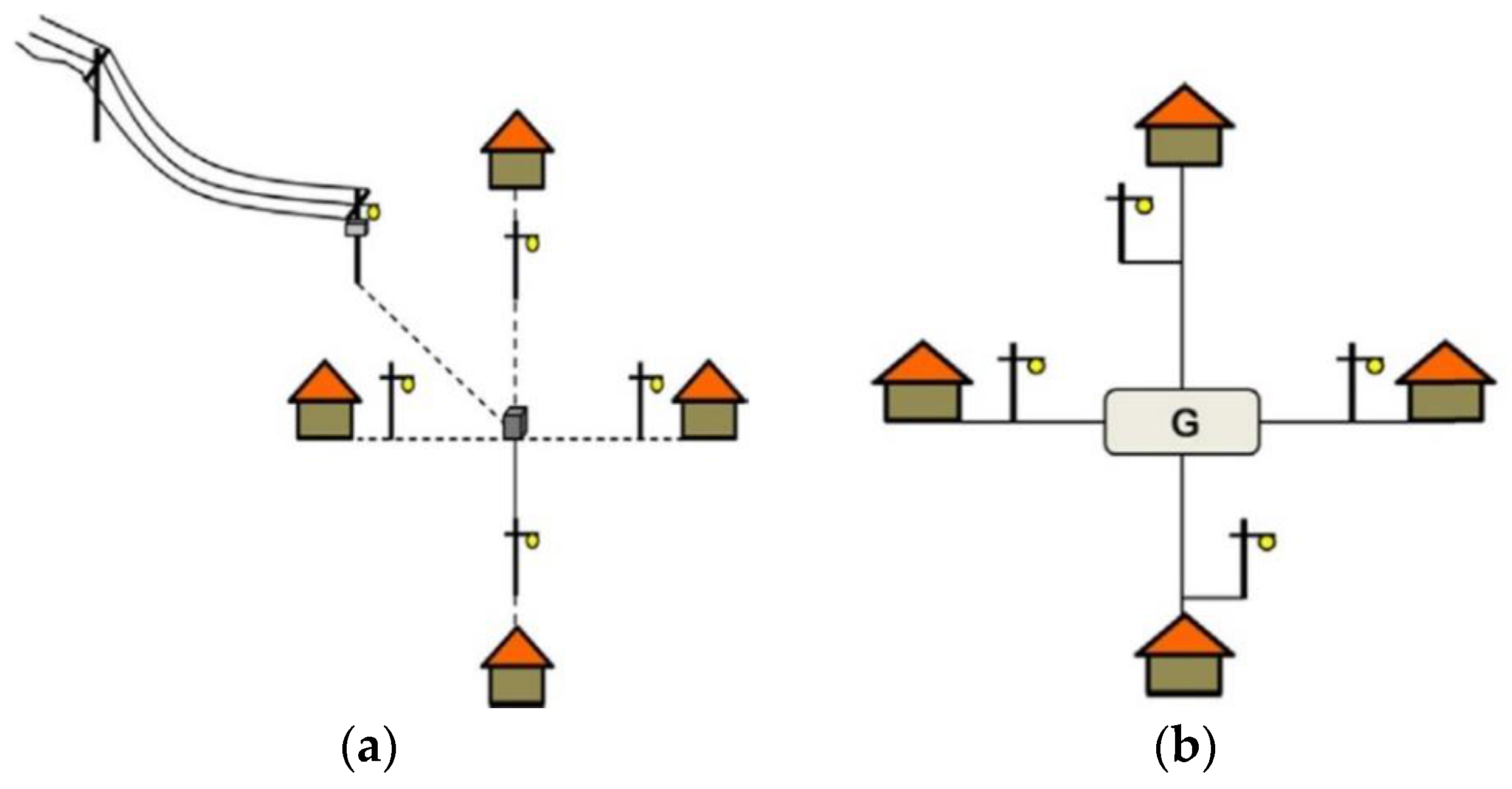
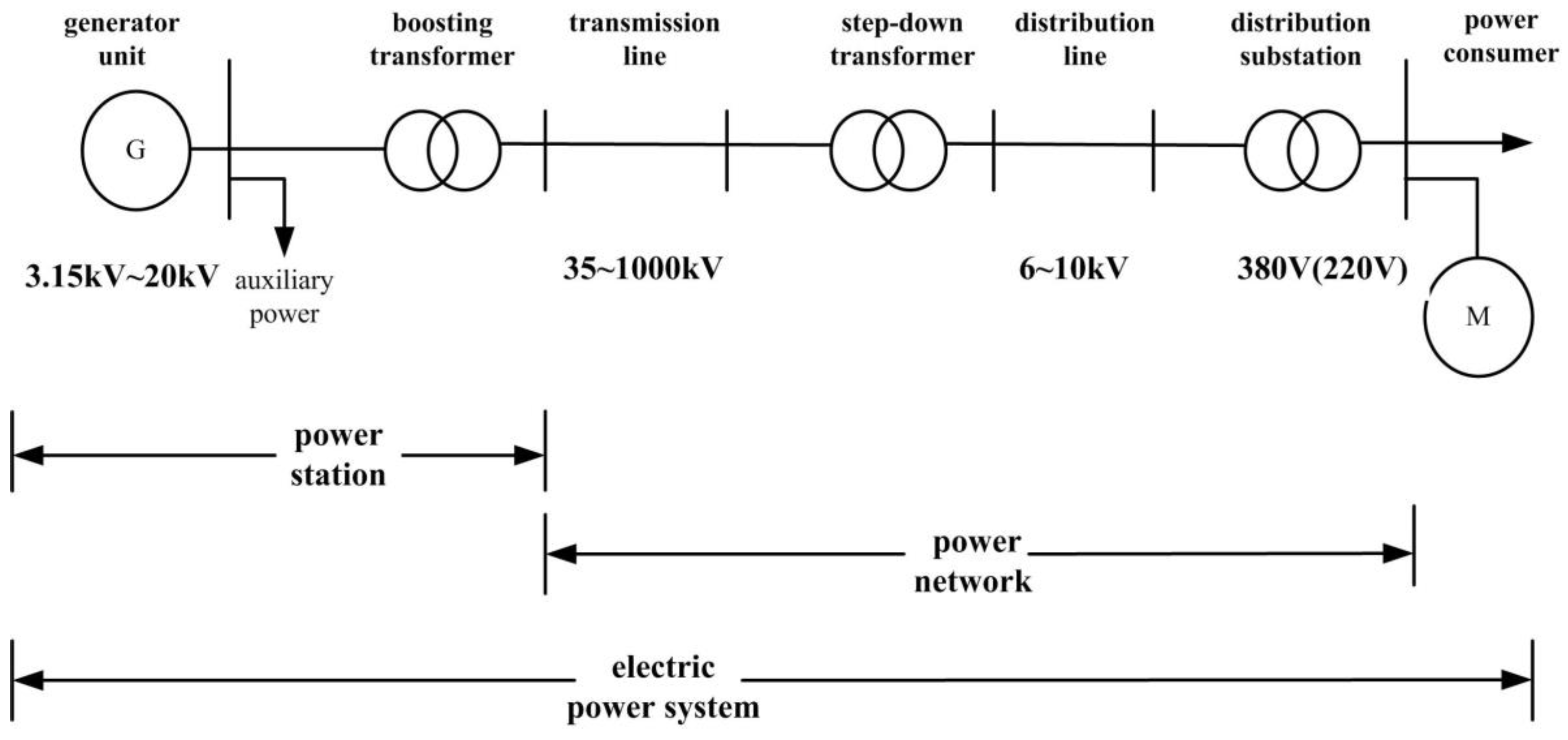
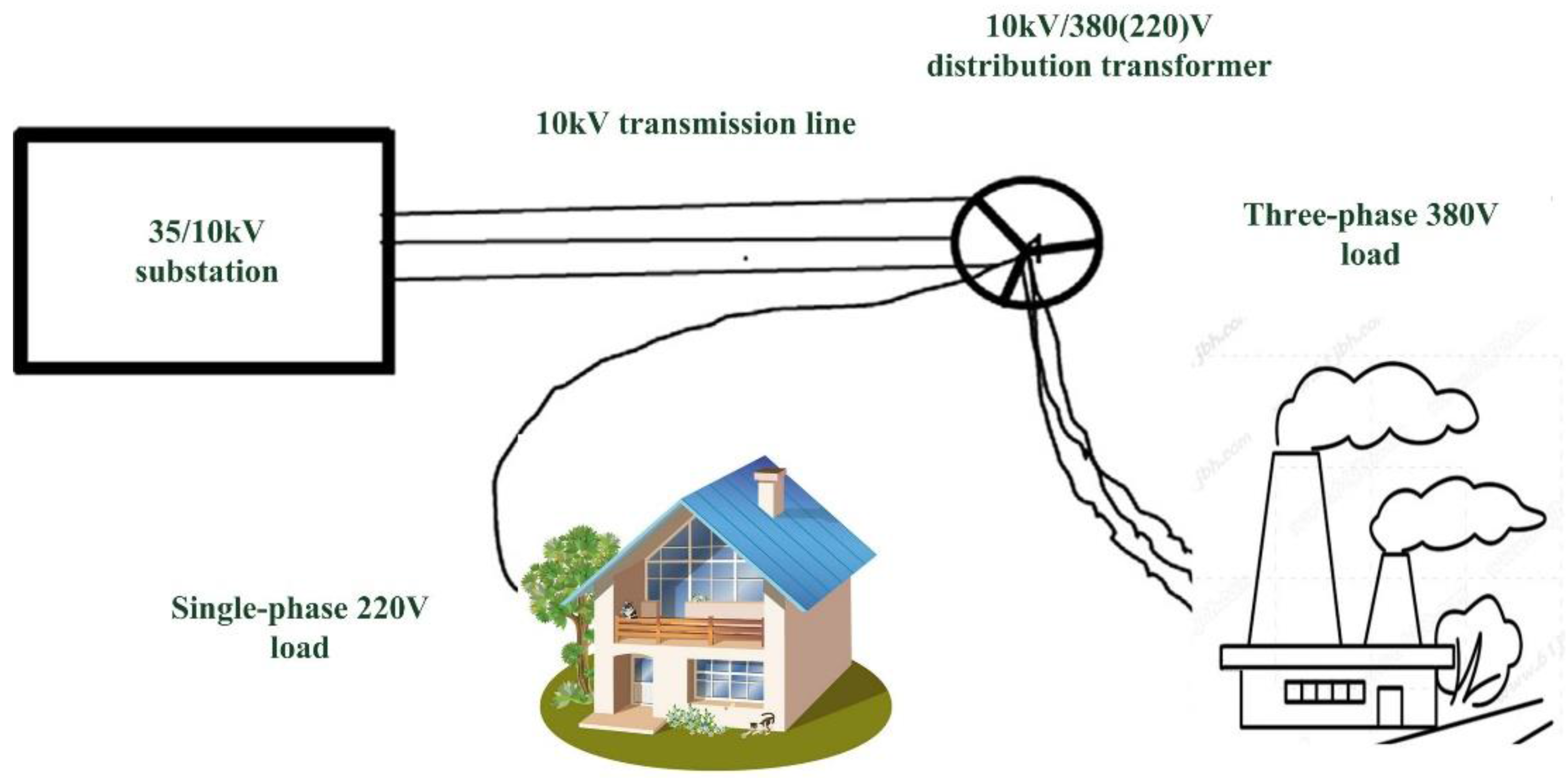
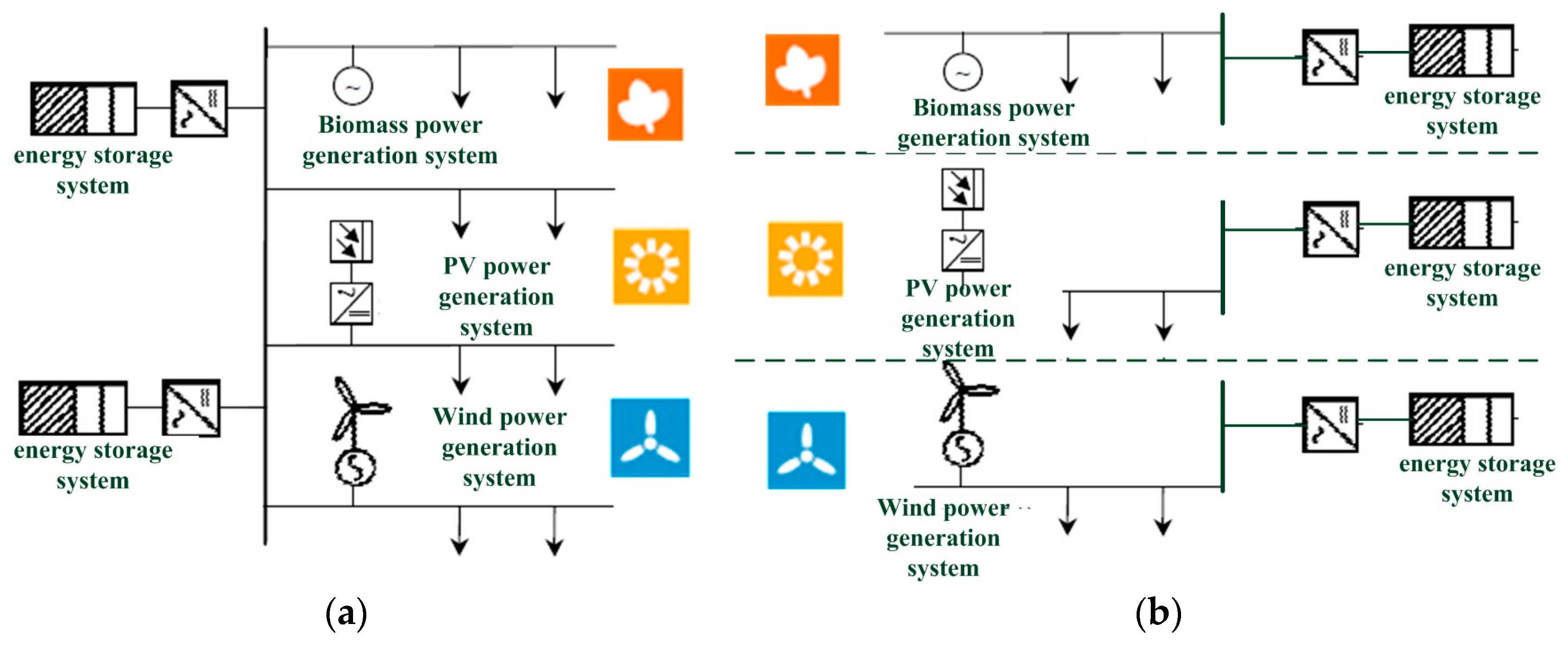
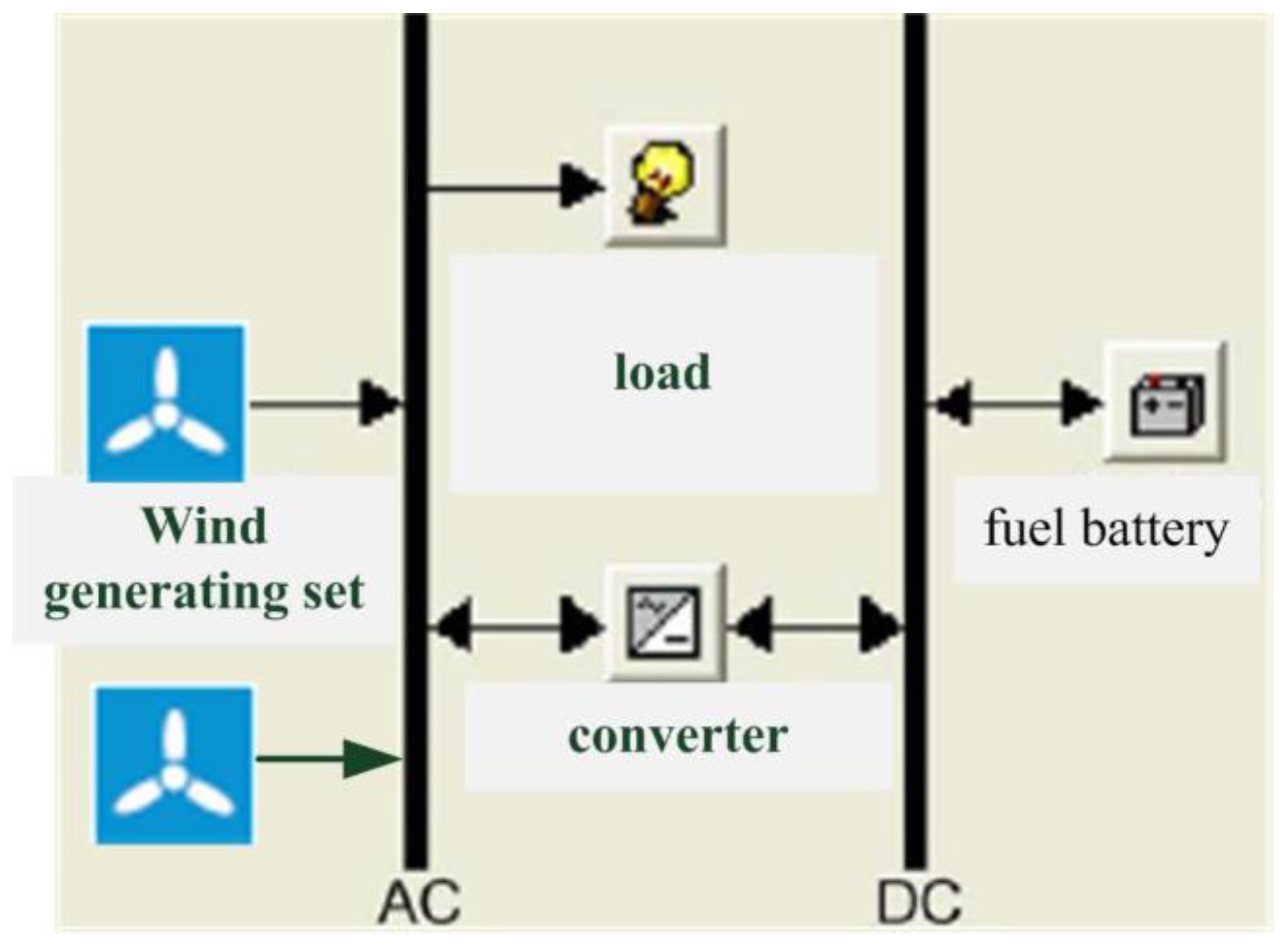
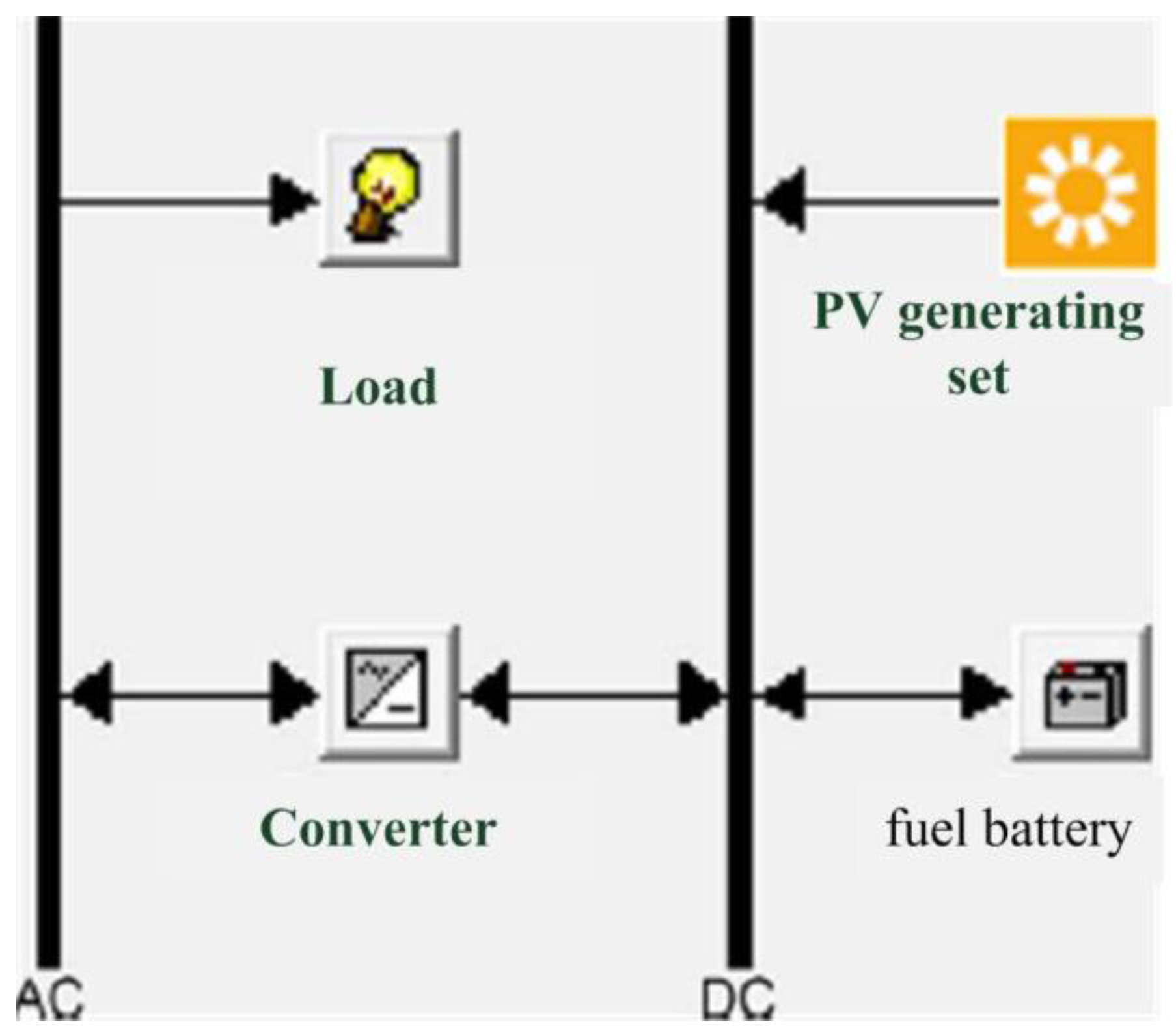

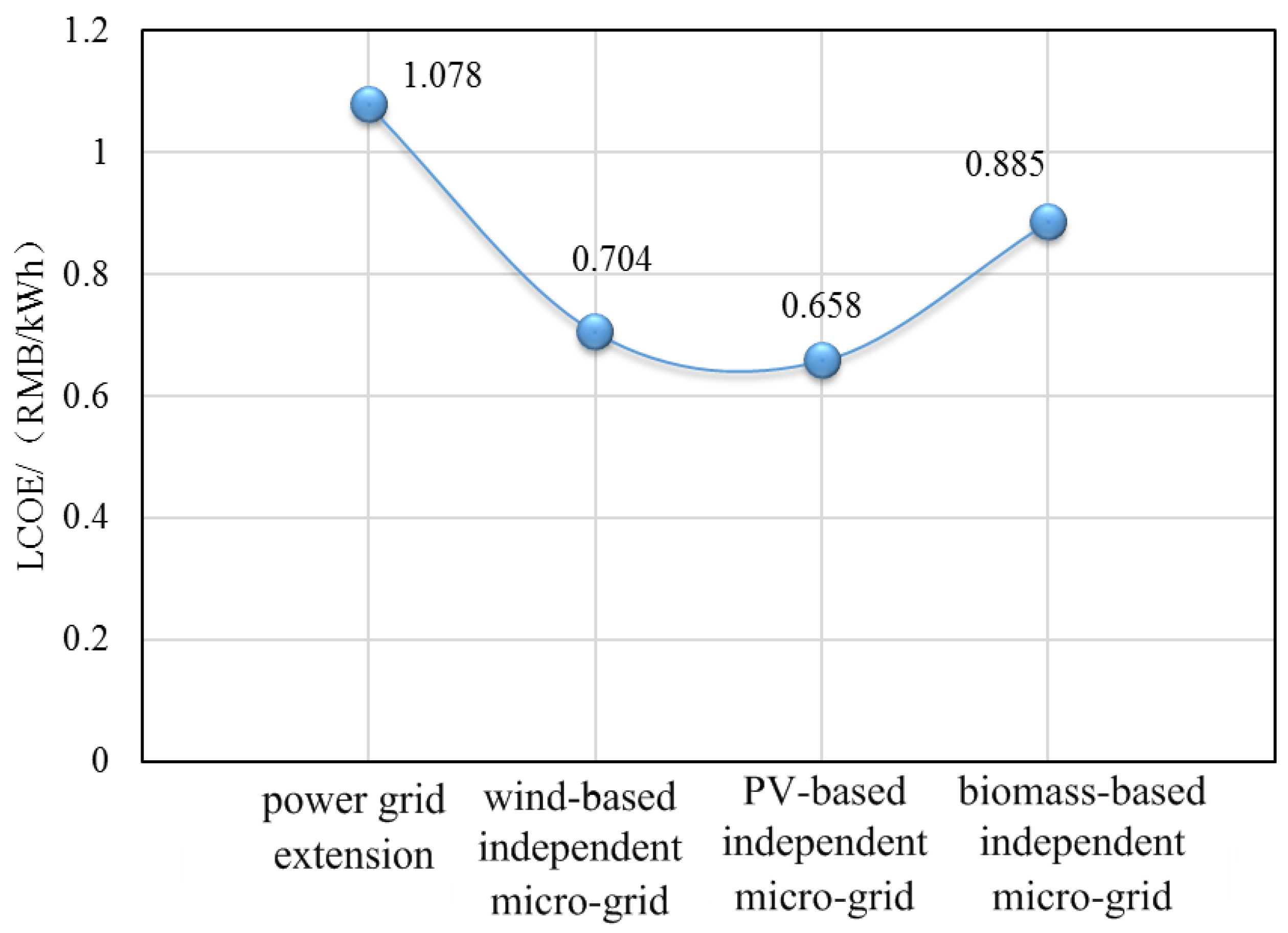
| Parameters | 250 MW Hydroelectric Units | 600 MW Coal-Fired Units |
|---|---|---|
| Generating capacity | 250 MW | 600 MW |
| Planned power generating hours | 4500 h | 4200 h |
| Own power consumption rate | 4% | 6% |
| Life cycle | 50 years | 25 years |
| Construction period | 4 years | 1 year |
| Construction investment cost | 1.75 billion RMB | 2.31 billion RMB |
| Own capital ratio | 20% | 20% |
| Feed-in tariffs | 0.27 RMB/kWh | 0.336 RMB/kWh |
| The proportion of operation and maintenance costs in total investment | 2% | 2.5% |
| increase 1% annually | increase 1% annually | |
| Premium rate | 0.25% | 0.25% |
| Loan interest rate | 6.12% | 6.12% |
| The share of other expenses in annual income | 2% | 2% |
| Wage and welfare | 6.05 million RMB | 63.47 million RMB |
| increase 2% annually | increase 2% annually | |
| Residual value of fixed assets | 5% | 5% |
| Value added tax | 17% | 17% |
| Urban maintenance and Construction tax | 5% | 4% |
| Education surtax | 3% | 3% |
| Corporate income tax | 25% | 25% |
| Parameters | Value |
|---|---|
| Transmission scale | 110 kV |
| Annual transmission capacity | 0.104 billion kWh |
| Line loss | 2% |
| Transformers loss | 1.8% |
| Construction time | 1 year |
| Construction investment cost | 16 million RMB |
| Life cycle | 25 years |
| Own capital ratio | 20% |
| The proportion of operation and maintenance costs in fixed investment | 1.6% |
| Premium rate | 0.25% |
| Loan interests rate | 6.12% |
| The proportion of wage and welfare in fixed investment | 1.22% |
| Residual value of fixed assets | 5% |
| Value added tax | 17% |
| Urban maintenance and construction tax | 5% |
| Education surtax | 3% |
| Corporate income tax | 25% |
| Parameters | Wind-Based Independent Micro-Grid System | PV-Based Independent Micro-Grid System | Biomass-Based Independent Micro-Grid System |
|---|---|---|---|
| System composition | two wind power generating sets with FD12.5–30 kW type; converter; fuel battery; and distribution lines | 60 kW photovoltaic generating set; converter; fuel battery; and distribution lines | 30 kW biomass power generation set; converter; fuel battery; and distribution lines |
| Initial investment | 425 thousand RMB | 8 RMB/W | 10.5 thousand RMB/kW |
| Service life | 20 years | 25 years | 20 years |
| The share of residual value | 5% | 5% | 5% |
| The share of Operation and maintenance cost | 2% | 0.2% in the first year; 0.5% in the second to eighth year, and 1% in the resting years | 2% |
| Own electricity consumption rate | 2% | 2% | 10% |
| Annual equivalent operating hours | 1900 h | 1500 h | 5500 h |
| Employment | Two employees | Two employees | Two employees |
| Monthly salary | 1000 RMB | 1000 RMB | 2000 RMB |
| Battery investment | 1500 RMB/kWh | 1500 RMB/kWh | 1500 RMB/kWh |
| Total acquisition cost of converter | 45 thousand RMB | 45 thousand RMB | 45 thousand RMB |
| Distribution lines length | 2.9 km | 2.9 km | 2.9 km |
| Others | Fuel cost: 200RMB/ton | ||
| LCOE | 0.704 RMB/kWh | 0.658 RMB/kWh | 0.885 RMB/kWh |
© 2017 by the authors. Licensee MDPI, Basel, Switzerland. This article is an open access article distributed under the terms and conditions of the Creative Commons Attribution (CC BY) license (http://creativecommons.org/licenses/by/4.0/).
Share and Cite
Guo, S.; Zhao, H.; Zhao, H. The Most Economical Mode of Power Supply for Remote and Less Developed Areas in China: Power Grid Extension or Micro-Grid? Sustainability 2017, 9, 910. https://doi.org/10.3390/su9060910
Guo S, Zhao H, Zhao H. The Most Economical Mode of Power Supply for Remote and Less Developed Areas in China: Power Grid Extension or Micro-Grid? Sustainability. 2017; 9(6):910. https://doi.org/10.3390/su9060910
Chicago/Turabian StyleGuo, Sen, Huiru Zhao, and Haoran Zhao. 2017. "The Most Economical Mode of Power Supply for Remote and Less Developed Areas in China: Power Grid Extension or Micro-Grid?" Sustainability 9, no. 6: 910. https://doi.org/10.3390/su9060910
APA StyleGuo, S., Zhao, H., & Zhao, H. (2017). The Most Economical Mode of Power Supply for Remote and Less Developed Areas in China: Power Grid Extension or Micro-Grid? Sustainability, 9(6), 910. https://doi.org/10.3390/su9060910





